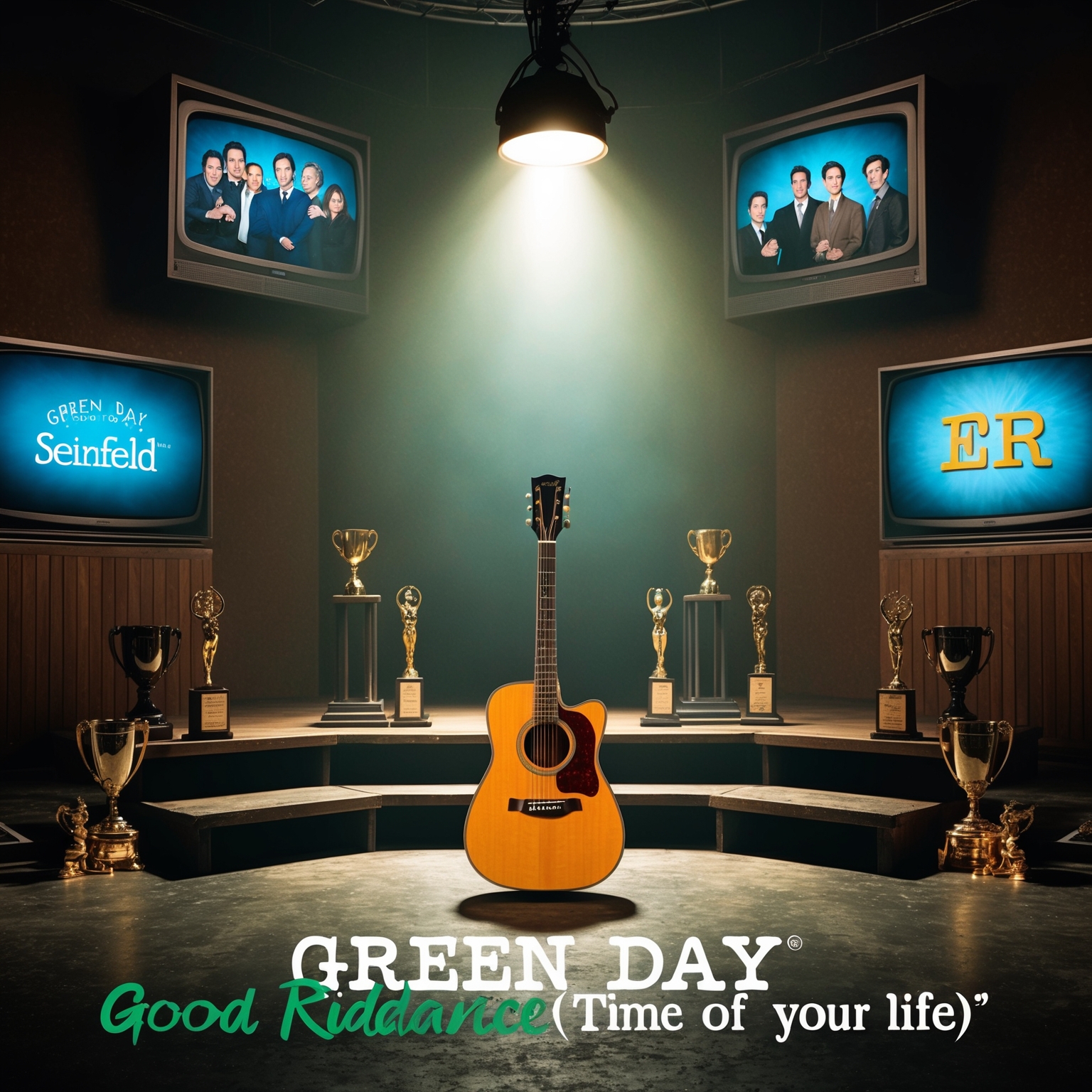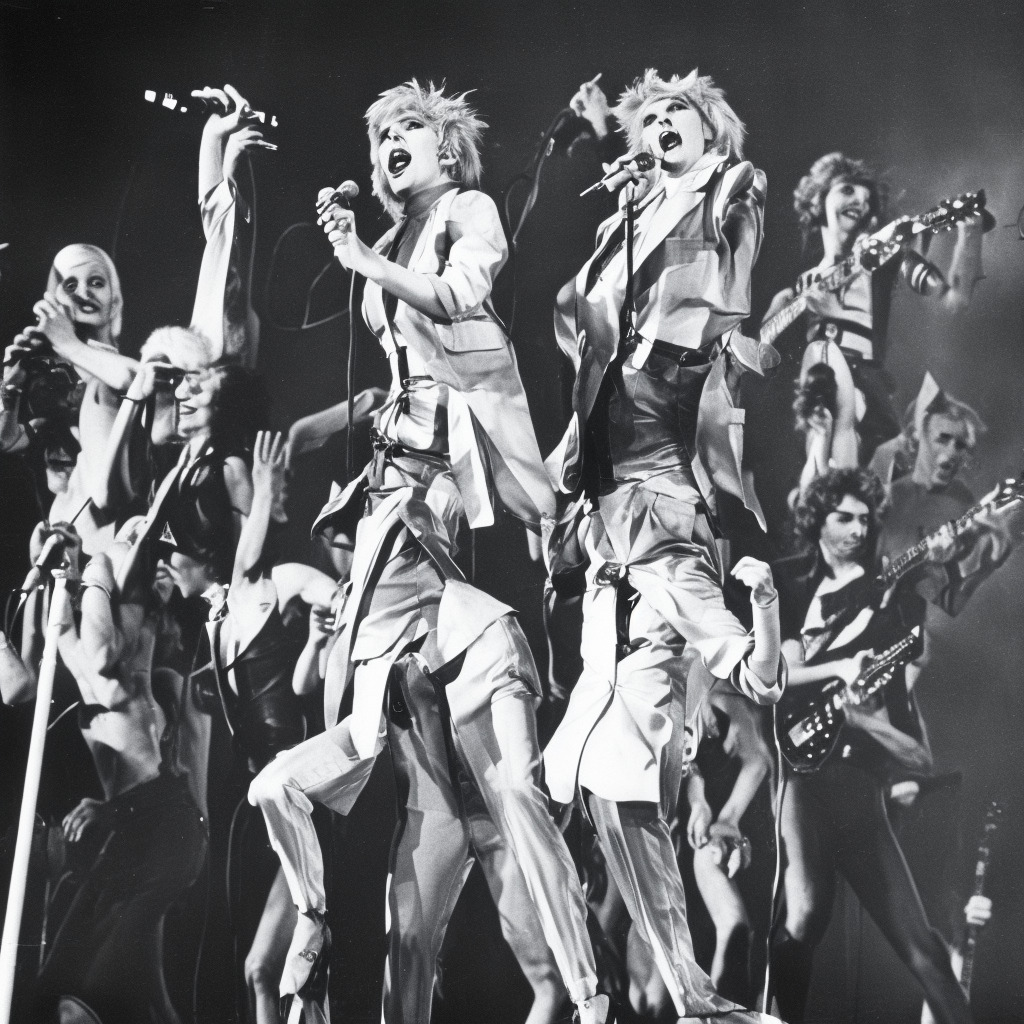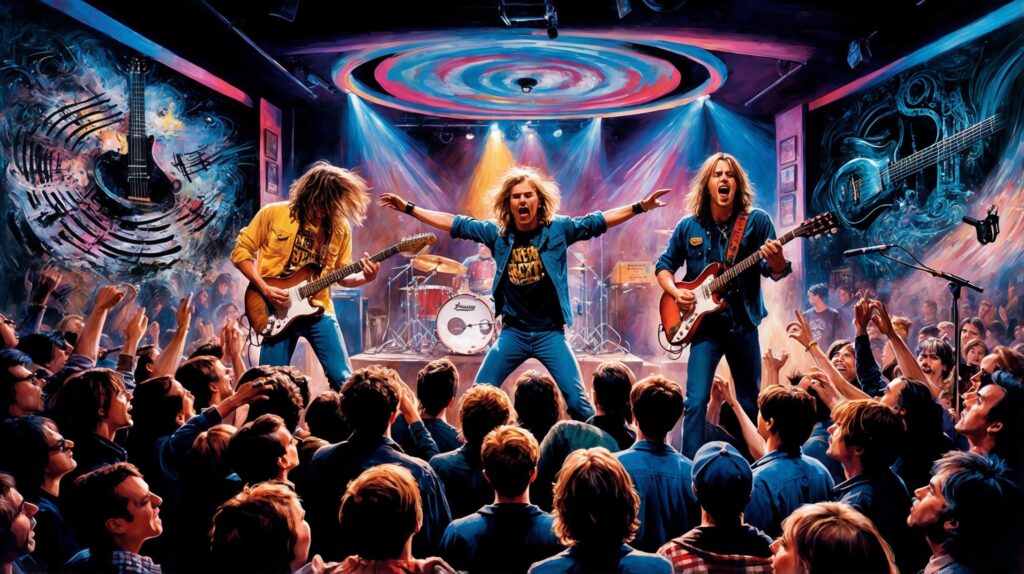Green Day: A Punk Rock Odyssey
Explore the punk rock journey of Green Day, a band that resonated with a generation, with a special emphasis on their iconic track, “Good Riddance (Time of Your Life).”

Green Day, an enduring name within the punk rock universe, emerged during the early 1990s, capturing the essence of a generation yearning for raw authenticity. Formed in 1987, in the heart of the East Bay punk scene in California, the band comprises of Billie Joe Armstrong, Mike Dirnt, and Tré Cool, who eventually became the trio known for revolutionizing mainstream punk music. Their third studio album, Dookie, catapulted them to international fame, but it was “Good Riddance (Time of Your Life)” from their fifth album, Nimrod, that showcased their musical versatility and connected deeply with audiences worldwide.
The band’s journey began when childhood friends Billie Joe Armstrong and Mike Dirnt, both hailing from humble beginnings, formed Green Day. Originally a part of the DIY punk scene, they played at various underground venues, capturing the rough edges of youth and rebellion in their music. It wasn’t long before they caught the attention of mainstream audiences, driving a punk rock revival that would dominate a decade. By the time “Good Riddance (Time of Your Life)” was released in 1997, Green Day had firmly established itself as one of the leading voices of punk, known for their energetic live performances and insightful songwriting.
A stark departure from their traditional sound, “Good Riddance” marked a poignant moment, juxtaposing acoustic melodies with introspective lyrics. The song’s enduring appeal is a testament to Green Day’s ability to evolve creatively while still maintaining their core identity. During this era, the band had matured in both their personal and professional lives, which reflected through the introspective nature of this track. The song’s heartfelt simplicity appealed to a broad audience, leading it to become one of Green Day’s most celebrated works, widely used in milestone events like graduations and farewells, cementing its place in cultural history.
The Creative Force Behind ‘Good Riddance’
Billie Joe Armstrong, as the lead composer of ‘Good Riddance,’ blends punk roots with an acoustic style, showcasing his versatility and emotive songwriting in this timeless Green Day classic.

Billie Joe Armstrong, the lead vocalist and guitarist of Green Day, is recognized as the primary composer of ‘Good Riddance (Time of Your Life).’ His journey as a musician began at a young age, deeply rooted in the punk rock scene. Born in Oakland, California, Armstrong’s introduction to music was influenced by his father’s jazz drummer career and his mother, who worked at a local diner. By the age of 14, he co-founded Green Day with bassist Mike Dirnt. Armstrong’s early career was defined by his unapologetic embrace of punk ethos, embodied subsequently in Green Day’s music.
Armstrong’s musical style is known for its fusion of punk rock energy with melodic pop sensibilities. The song ‘Good Riddance’ marks a departure from punk, revealing his ability to craft a poignant acoustic ballad. He often cites influences from bands like The Ramones and The Clash, yet his versatility stretches beyond, capturing elements of folk and alternative rock. Armstrong’s lyrical approach in ‘Good Riddance’ mirrors his personal experiences, exploring themes of reflection and change.
In writing ‘Good Riddance’, Armstrong played a multifaceted role, handling both the lyrics and the music composition. The song was initially written during the sessions for their third album, ‘Dookie’, but was not included until their follow-up album, ‘Nimrod.’ Its arrangement, stripped down to an acoustic guitar and strings, allowed Armstrong’s poignant songwriting to shine. This simplicity contrasted with their typical high-energy punk rock tracks, showcasing his depth as a composer and further endearing the song to audiences worldwide.
Billie Joe Armstrong: The Creative Force Behind ‘Good Riddance’
Discover the genius of Billie Joe Armstrong, the creative force behind Green Day’s ‘Good Riddance’, exploring his unique musical style and influences.

Billie Joe Armstrong, the lead vocalist and guitarist of Green Day, is the driving creative force behind ‘Good Riddance (Time of Your Life)’. Born in Oakland, California, Armstrong displayed a passion for music from an early age, leading him to form Green Day with bassist Mike Dirnt in the late 1980s. Armstrong’s musical journey is one of defiance and innovation, exploring the boundaries of punk rock while also embracing mainstream appeal.
Armstrong’s musical style is characterized by its blend of punk energy and melodic elements, often infused with personal and reflective lyrics. He draws inspiration from various musical influences, ranging from the raw edge of punk bands like the Ramones and the Clash to the melodic sensibilities of classic rock acts. His ability to bridge different musical worlds has made him a distinct voice in the rock genre, contributing to Green Day’s lasting appeal.
In the case of ‘Good Riddance’, Armstrong’s role extended beyond just composing; he was pivotal in shaping the song’s reflective tone and acoustic arrangement, a departure from Green Day’s typical electric guitar-driven sound. The song’s wistful lyrics paired with its gentle melody provided a new dimension to Armstrong’s songwriting skill, illustrating his versatility as a composer.
Recognizing the Impact of a Farewell Anthem
“Good Riddance (Time of Your Life)” by Green Day is a cultural icon, noted for its emotional depth and frequent media appearances, along with notable covers that underscore its lasting impact.

“Good Riddance (Time of Your Life)” by Green Day isn’t just a song; it’s a cultural staple that’s been recognized for its emotional resonance and authenticity. While the song itself wasn’t a major contender in prestigious music awards, its lasting impact and enduring presence in popular culture speak volumes. One of the most notable accolades came when it was listed among the ‘500 Greatest Songs of All Time’ by prestigious publications, underscoring its timeless appeal and influence.
One of the unique aspects of “Good Riddance” is its frequent use in media, further amplifying its widespread recognition. The song has made memorable appearances in numerous television shows such as the finale of “Seinfeld” and the series “ER,” where it was used to underscore poignant moments. This widespread exposure highlights its ability to capture feelings of nostalgia, transition, and reflection, which resonates deeply with audiences across different demographics.
Beyond the awards and media appearances, “Good Riddance” has inspired several notable covers. Artists across various genres have taken to putting their own spin on the beloved tune, ensuring that new interpretations keep emerging. Such covers include those by Glen Campbell, who included it in his “Meet Glen Campbell” album, and more contemporary renditions by artists at televised talent shows, each adding a touch of their personal style to the iconic piece. These covers validate the song’s universal message and timeless allure, proving its lasting significance across generations.
The Climb to Chart-Topping Fame
“Good Riddance (Time of Your Life)” by Green Day initially had a modest chart debut, but its lasting impact has proven it to be an enduring classic. Despite not reaching top chart positions upon its release, the song resonated deeply with audiences, growing in popularity through strategic placements and cultural moments. Its legacy endures in its timeless appeal and adaptability across media and contexts, culminating in a track cherished by many for life’s significant moments.

Released on October 17, 1997, “Good Riddance (Time of Your Life)” by Green Day may not have immediately topped the charts, but its impact has been undeniable. Initially, the song did not shoot to the number one spot. Instead, it debuted in a humble position on the Billboard Hot 100. Yet, over time, “Good Riddance” found its way into listeners’ hearts, climbing steadily until it became one of Green Day’s signature tracks. Its peak position on the charts may not mirror its true cultural weight, as the song resonates with audiences far beyond initial expectations.
“Good Riddance” defies typical chart success stories where songs often experience an immediate surge. Instead, it showcases how some tracks grow over time, gaining popularity through word-of-mouth and strategic advertisement placements. As compared to other well-known Green Day tracks, like the raw and energetic “Basket Case,” this song reveals a more reflective side of the band. It underscores Green Day’s versatility, allowing them to tap into new fanbases. The song proved to be a pivotal moment in their career, maintaining their established punk identity while broadening their artistic reach.
The marketing and promotion for “Good Riddance” relied heavily on its inclusion in various TV shows and movies, steadily increasing its visibility. Its use in emotional contexts, such as season finales and farewell montages, solidified its status in popular culture. While it may not have been a chart-topping sensation upon release, “Good Riddance” has a long-lasting legacy that continues to resonate, serving as a sentimental anthem for goodbye moments and significant life transitions. To this day, its presence remains strong in streaming numbers and social media playlists, showcasing its timeless appeal.
The Visual Journey of ‘Good Riddance’
The music video for ‘Good Riddance (Time of Your Life)’ by Green Day uses simplistic, warm visuals to capture the song’s introspective themes, resonating deeply with audiences.

The music video for Green Day’s iconic track “Good Riddance (Time of Your Life)”, directed by Mark Kohr, perfectly encapsulates the reflective and intimate nature of the song. Unlike the fast-paced, rebellious visuals often associated with the band, this video takes a more subdued and poignant approach, focusing on the introspective themes of the song.
Shot with a warm, sepia-toned filter, the video features lead singer Billie Joe Armstrong playing an acoustic guitar, interspersed with vignettes of ordinary people experiencing pivotal moments in their lives. This setup effectively communicates the personal and universal nature of the song, depicting a collage of life’s poignant and fleeting moments. The simplicity of these visuals allows the song’s emotional depth to take center stage, aligning perfectly with its lyrical content.
While the music video didn’t feature any high-profile celebrities, its authenticity resonated strongly with audiences. Critics have praised the video for its minimalistic yet impactful storytelling, which elevated the song to new heights of emotional resonance. The video’s emphasis on raw emotion and the simplicity of life’s experiences contributed significantly to the enduring success of “Good Riddance,” ensuring its status as a timeless Green Day classic.
Breaking Down the Musical Anatomy of ‘Good Riddance (Time of Your Life)’
Explore the artistic shift and acoustic simplicity behind Green Day’s ‘Good Riddance (Time of Your Life),’ a song whose melodic structure and instrumental nuances mark a significant evolution in their musical journey.

Analyzing the musical structure of Green Day’s ‘Good Riddance (Time of Your Life)’ reveals a departure from the band’s typical punk rock roots, embracing a more acoustic sound. Written in the key of G major, the song utilizes a common chord progression of G-Cadd9-D-Em that underlines its reflective and poignant tone. The straightforward tempo sits at approximately 90 beats per minute, providing a steady rhythm that aligns with its introspective lyrics.
The melodic simplicity of ‘Good Riddance’ is a significant factor in its widespread appeal. The harmony is accentuated by the clean strumming of the acoustic guitar, which carries the main melody. The rhythm here plays a crucial role, with a consistent strum pattern that underpins the vocal delivery, adding a layer of heartfelt resonance to the performance. Additionally, strings subtly layered in the background introduce an emotional depth to the texture, elevating the song’s sentimentality.
Instrumentally, ‘Good Riddance’ is marked by its minimalist approach. The acoustic guitar dominates the soundscape, providing both harmonic and rhythmic foundations. Secondary elements like strings introduce a touch of warmth. This simplicity contrasts sharply with Green Day’s earlier work, illustrating an evolution from their aggressive punk sound toward a more diverse musical expression. This song stands as a pivotal point in their discography, showcasing a matured thematic exploration distinct from prior albums such as ‘Dookie’ and foreshadowing future, varied artistic directions. Anecdotes from the recording sessions reveal that the song was initially met with resistance from the band’s producer, Rob Cavallo, who later embraced its unique sound, marking a critical moment of creative decision during the band’s recording process at Hyde Street Studios in San Francisco.
Decoding the Musical Fabric of ‘Good Riddance (Time of Your Life)’
Explore the unique musical structure of Green Day’s ‘Good Riddance’, highlighting its acoustic essence, its harmonically simple yet deep arrangement, and its significance in the band’s evolution.

‘Good Riddance (Time of Your Life)’ by Green Day stands as a poignant and enduring piece of their musical repertoire, renowned for its departure from the band’s characteristic punk rock roots. Analyzing its structure unravels a fascinating blend of simplicity and emotional depth.
The song is written in the key of G major, a choice that contributes to its warm and reflective tone. With a tempo of approximately 90 beats per minute, ‘Good Riddance’ is a slow ballad that offers a contemplative pause amidst Green Day’s typically fast-paced discography. The song’s chord progression is straightforward, primarily revolving around the chords G, Cadd9, D, and Em, which provide a harmonic foundation that complements the introspective lyrics.
The melody rides on the delicate interplay of Billie Joe Armstrong’s acoustic guitar and his earnest vocal delivery. Armstrong’s vocals bring a heartfelt sincerity, enhanced by the string arrangement that adds layers of harmonic richness without overshadowing the acoustic simplicity. The rhythm maintains a gentle, flowing quality, driven by strumming patterns that match the song’s reflective mood. This stark contrast to Green Day’s typical electric guitar and aggressive drumming showcases the band’s versatility.
Produced by Rob Cavallo, the track was recorded at Hyde Street Studios in San Francisco. The acoustic focus was a deliberate artistic choice that marked a notable evolution in the band’s sound, hinting at broader thematic maturity. This song provides a critical marker in Green Day’s discography, illustrating the group’s willingness to experiment and emotional depth unseen in earlier punk anthems.
Exploring the Nuances of ‘Good Riddance (Time of Your Life)’ Lyrics
In ‘Good Riddance (Time of Your Life),’ Green Day captures life’s unpredictable journey through reflective lyrics infused with universal themes. The song’s straightforward narrative allows listeners to relate their personal experiences, while its clever use of metaphor and contrasting themes ensures its lasting impact.
Another turning point, a fork stuck in the road
Time grabs you by the wrist, directs you where to go
So make the best of this test, and don’t ask why
It’s not a question, but a lesson learned in time
It’s something unpredictable
But in the end, is right
…
******* This Lyrics is NOT for Commercial use *******

The lyrics of Green Day’s ‘Good Riddance (Time of Your Life)’ resonate with audiences through their contemplative themes and universal applicability. The song captures a pensive moment of reflection where the narrator contemplates life’s unpredictable nature. At its core, the song talks about choices and inevitable changes—a concept beautifully illustrated in the opening line, “Another turning point, a fork stuck in the road.” The use of metaphor here points to life’s uncertainty and the inevitable decisions we must make as we journey on.
The narrative style of the song is straightforward yet deeply impactful, employing a first-person perspective that invites listeners to relate to their personal experiences. Rather than guiding the audience through a specific story, it allows them to project their own journeys and struggles onto the lyrics. This flexibility in storytelling ensures that the song remains timeless and relevant, evoking emotions even decades after its release.
Delving into the literary devices used within the lyrics, the metaphor of time as a guiding force is particularly striking. Phrases such as “Time grabs you by the wrist, directs you where to go” encapsulate the relationship between humans and the passage of time, suggesting an inevitable submission to life’s flow. Furthermore, the song cleverly plays with contrasting themes—uncertainty versus resolution—concluded in the lines, “It’s something unpredictable, but in the end, is right.” This juxtaposition encapsulates the essence of coming to terms with life’s unpredictability, yet finding solace in the possibility of a “right” outcome.
Culturally, ‘Good Riddance’ taps into a universal sentiment, often becoming an anthem for milestones like graduations and farewells. The simplicity and straightforwardness of the language make it accessible, while the emotional weight it carries ensures its position as a song that transcends generational divides. Listeners interpret this track in various ways, often seeing it as both a farewell and a commencement, making it an embodiment of dual themes—endings and new beginnings.
? Did you know Good Riddance (Time of Your Life) was initially hesitant for Green Day to release? Now it’s a classic farewell anthem! ? #ThrowbackThursday #GreenDay #FunFact https://bit.ly/3ZiO5SZ
Click to Tweet







